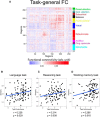Higher Intelligence Is Associated with Less Task-Related Brain Network Reconfiguration
- PMID: 27535904
- PMCID: PMC4987432
- DOI: 10.1523/JNEUROSCI.0358-16.2016
Higher Intelligence Is Associated with Less Task-Related Brain Network Reconfiguration
Abstract
The human brain is able to exceed modern computers on multiple computational demands (e.g., language, planning) using a small fraction of the energy. The mystery of how the brain can be so efficient is compounded by recent evidence that all brain regions are constantly active as they interact in so-called resting-state networks (RSNs). To investigate the brain's ability to process complex cognitive demands efficiently, we compared functional connectivity (FC) during rest and multiple highly distinct tasks. We found previously that RSNs are present during a wide variety of tasks and that tasks only minimally modify FC patterns throughout the brain. Here, we tested the hypothesis that, although subtle, these task-evoked FC updates from rest nonetheless contribute strongly to behavioral performance. One might expect that larger changes in FC reflect optimization of networks for the task at hand, improving behavioral performance. Alternatively, smaller changes in FC could reflect optimization for efficient (i.e., small) network updates, reducing processing demands to improve behavioral performance. We found across three task domains that high-performing individuals exhibited more efficient brain connectivity updates in the form of smaller changes in functional network architecture between rest and task. These smaller changes suggest that individuals with an optimized intrinsic network configuration for domain-general task performance experience more efficient network updates generally. Confirming this, network update efficiency correlated with general intelligence. The brain's reconfiguration efficiency therefore appears to be a key feature contributing to both its network dynamics and general cognitive ability.
Significance statement: The brain's network configuration varies based on current task demands. For example, functional brain connections are organized in one way when one is resting quietly but in another way if one is asked to make a decision. We found that the efficiency of these updates in brain network organization is positively related to general intelligence, the ability to perform a wide variety of cognitively challenging tasks well. Specifically, we found that brain network configuration at rest was already closer to a wide variety of task configurations in intelligent individuals. This suggests that the ability to modify network connectivity efficiently when task demands change is a hallmark of high intelligence.
Keywords: brain connectivity; cognitive control; fMRI; individual differences; intelligence; task switching.
Copyright © 2016 the authors 0270-6474/16/368551-11$15.00/0.
Figures





Similar articles
-
Principal States of Dynamic Functional Connectivity Reveal the Link Between Resting-State and Task-State Brain: An fMRI Study.Int J Neural Syst. 2018 Sep;28(7):1850002. doi: 10.1142/S0129065718500028. Epub 2018 Jan 25. Int J Neural Syst. 2018. PMID: 29607681
-
Correspondence between evoked and intrinsic functional brain network configurations.Hum Brain Mapp. 2017 Apr;38(4):1992-2007. doi: 10.1002/hbm.23500. Epub 2017 Jan 4. Hum Brain Mapp. 2017. PMID: 28052450 Free PMC article.
-
Effects of task complexity and age-differences on task-related functional connectivity of attentional networks.Neuropsychologia. 2018 Jun;114:50-64. doi: 10.1016/j.neuropsychologia.2018.04.013. Epub 2018 Apr 12. Neuropsychologia. 2018. PMID: 29655800
-
Human intelligence and brain networks.Dialogues Clin Neurosci. 2010;12(4):489-501. doi: 10.31887/DCNS.2010.12.4/rcolom. Dialogues Clin Neurosci. 2010. PMID: 21319494 Free PMC article. Review.
-
Task-based dynamic functional connectivity: Recent findings and open questions.Neuroimage. 2018 Oct 15;180(Pt B):526-533. doi: 10.1016/j.neuroimage.2017.08.006. Epub 2017 Aug 3. Neuroimage. 2018. PMID: 28780401 Free PMC article. Review.
Cited by
-
A Whole-Brain and Cross-Diagnostic Perspective on Functional Brain Network Dysfunction.Cereb Cortex. 2021 Jan 1;31(1):547-561. doi: 10.1093/cercor/bhaa242. Cereb Cortex. 2021. PMID: 32909037 Free PMC article.
-
A graph representation of functional diversity of brain regions.Brain Behav. 2019 Sep;9(9):e01358. doi: 10.1002/brb3.1358. Epub 2019 Jul 27. Brain Behav. 2019. PMID: 31350830 Free PMC article.
-
Variability and stability of large-scale cortical oscillation patterns.Netw Neurosci. 2018 Oct 1;2(4):481-512. doi: 10.1162/netn_a_00046. eCollection 2018. Netw Neurosci. 2018. PMID: 30320295 Free PMC article.
-
Activation-based association profiles differentiate network roles across cognitive loads.Hum Brain Mapp. 2019 Jun 15;40(9):2800-2812. doi: 10.1002/hbm.24561. Epub 2019 Mar 10. Hum Brain Mapp. 2019. PMID: 30854745 Free PMC article.
-
Multi-timepoint pattern analysis: Influence of personality and behavior on decoding context-dependent brain connectivity dynamics.Hum Brain Mapp. 2022 Mar;43(4):1403-1418. doi: 10.1002/hbm.25732. Epub 2021 Dec 3. Hum Brain Mapp. 2022. PMID: 34859934 Free PMC article.
References
-
- Ahlgren P, Jarneving B, Rousseau R. Requirements for a cocitation similarity measure, with special reference to Pearson's correlation coefficient. J Am Soc Inf Sci. 2003;54:550–560. doi: 10.1002/asi.10242. - DOI
-
- Barch DM, Burgess GC, Harms MP, Petersen SE, Schlaggar BL, Corbetta M, Glasser MF, Curtiss S, Dixit S, Feldt C, Nolan D, Bryant E, Hartley T, Footer O, Bjork JM, Poldrack R, Smith S, Johansen-Berg H, Snyder AZ, Van Essen DC, WU-Minn HCP Consortium Function in the human connectome: task-fMRI and individual differences in behavior. Neuroimage. 2013;80:169–189. doi: 10.1016/j.neuroimage.2013.05.033. - DOI - PMC - PubMed
-
- Benjamini Y, Hochberg Y. Controlling the false discovery rate: a practical and powerful approach to multiple testing. J R Stat Soc Series B Stat Methodol. 1995;57:289–300.
Publication types
MeSH terms
Substances
Grants and funding
LinkOut - more resources
Full Text Sources
Other Literature Sources
